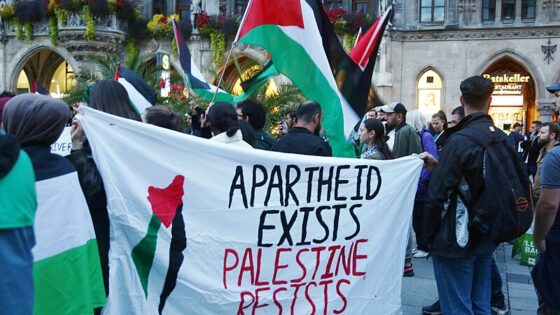In 2014 and 2015, mock eviction notices hung in a predominantly Jewish dormitory at NYU; a UCLA student’s qualifications for a judicial board were questioned because of her religion; and a Stanford student government candidate scrubbed her Facebook page of pro-Israel activity for fear of the repercussions.
These are not isolated incidents, but rather manifestations of a larger problem at universities that the boycott, divestment, and sanctions (BDS) movement is only exacerbating. Thirty-seven U.S. universities, including elite schools, had BDS campaigns this academic year – more than the previous two years combined.
Following the launch of the current BDS movement in July 2005, university campaigns took the form of student government resolutions. The campaign has morphed over the past few years, where today university-wide referendums on select campuses, alongside resolutions, significantly broaden the campaign’s impact. (University boards have not adopted the student recommendations, so far.) Support for BDS has also spread from Middle East studies departments to social sciences and humanities faculties – the issue was even taken up by the American Studies Association and Modern Language Association.
Instead of the merits of the issues being addressed, as the New York Times noted last week, this is turning into a proxy conflict pitting Jewish students against minority students including students of different sexual orientation. Jewish students, who have usually considered themselves a minority, are suddenly told they part of the American “power structure” and “privileged”.
Given America’s increasingly multi-ethnic makeup, the appeal of BDS arguments could grow. According to Gallup, Americans older than 65 support Israel’s actions by a margin of 24 points, but those younger than 30 oppose these actions by 26 points. Additionally, while white Americans backed last summer’s Gaza war by 16 points, non-whites opposed it by 24 points.
The driving force for BDS on campus is Students for Justice in Palestine (SJP), with approximately 115 chapters. SJP has actively sought to attract minority or underprivileged students—as evident in the title of its latest conference, Beyond Solidarity: Resisting Racism and Colonialism from the U.S. to Palestine. In 2011, a student-led course at Berkeley explored “the similarities between Palestinian, Mexican and other oppressed communities and their struggles against exclusionary practices.”
Such charges can be powerful for students who feel marginalized — and who may, in turn, fail to notice that minorities in Israel fare far better especially compared with many other Middle East countries. Indeed, context is relevant. When president of Harvard, Lawrence Summers said context is completely missing. “We live in a world where there are nations in which the penalty for homosexuality is death…in which governments are killing tens of thousands of their own people each year. But the proponents of Israeli [BDS] do not favor any form of pressure against countries “other than Israel.” In a Columbia University speech earlier this year, he reiterated that he viewed the BDS move as “anti-semitism by effect, if not intent.” He added, “the general failure of American academic leaders to aggressively take on the challenge posed by the Boycott, Divestment, Sanction (BDS)movement represents a consequential abdication of moral responsibility.”
It is clear that the Jewish students are made to feel uncomfortable. They are often told, ‘you are with the oppressors or with the oppressed.’ Take the case of Anya Friedman Hutter, who transferred from Oberlin College due to its “toxic climate.” In August 2014, she wrote in the Jewish Exponent of “‘the liberal checklist.’ [We] were expected [to denounce] a plethora of social evils, including capitalism, racism, fracking, transphobia—and Israel.” It is estimated swastikas at fourteen different Jewish fraternities across the country have suddenly popped up during this academic year, often at places where BDS resolutions emerge. Yet, its perpetrators are unknown.
SJP is importing the Middle Eastern politics of confrontation instead of exporting American values of coexistence and pluralism. The refusal of SJP activists to even talk to those with whom they disagree because it “normalizes” the opponent is antithetical to what a university should be—a safe haven for the free exchange of ideas. The Palestinian Campaign for the Academic & Cultural Boycott of Israel asks SJP to only participate in events “framed within the explicit context of opposition to occupation and other forms of Israeli oppression of the Palestinians.” While the BDS movement seeks to define the parameters of acceptable political speech, it rejects all points of view except its own.
Stanford University president John Hennessy remarked recently, “[In] 15 years…I have never seen a topic that has been more divisive.”
The consequences of this movement will be severe if unchecked. Polarization doesn’t lead just to overheated polemics; it also leads to extreme moves such as those at UCLA and Stanford. And the extremism isn’t one-sided. The self-described pro-Israel David Horowitz Freedom Center recently plastered multiple campuses with posters linking SJP to the terrorist group Hamas through notorious photographs of executions.
Yet, beyond an endangered campus climate, the greatest threat of BDS is its ability to undermine a two-state solution. If one hopes to maintain the integrity of Israelis and Palestinians with two states for two peoples, de-legitimizing one side can only hinder progress.
Undercutting a two-state solution runs counter to American interests. Officially, the BDS National Committee (BNC) takes no position on the two-state solution. However, its advocates do not promote such an outcome and the committee fails to recognize Israel’s right to exist. Founding BNC member Omar Barghouti claims, “The only ethical solution is a (single) democratic, secular and civic state in historic Palestine.”
None of this is to say Israeli policies should be immune to critique, but when it leads to delegitimization, it becomes dangerous to our campuses and prospects for peace. Protests should be aimed at ending a conflict that has persisted for decades—not fueling the fire.
So don’t divest; invest in understanding and academic dialogue. If our campuses become a battleground, how are we making it easier for peaceful reconciliation between Palestinians and Israelis?
—
David Makovsky, the Ziegler Distinguished Fellow and director of the Program on the Middle East Peace Process at the Washington Institute for Near East Policy, has visited more than 70 distinct universities (and some campuses several times) in the last six years to discuss the Israeli-Palestinian conflict.
Raquel Saxe, a former research associate at The Washington Institute, is a former student government leader and was president of the Jewish Student Union at UCLA.




